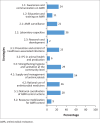Overview of antimicrobial resistance mitigation efforts in Benin 2024
- PMID: 40799379
- PMCID: PMC12339761
- DOI: 10.4102/jphia.v16i1.1332
Overview of antimicrobial resistance mitigation efforts in Benin 2024
Abstract
Background: Antimicrobial resistance (AMR) is a significant global public health threat that undermines sustainable development. In Benin, high AMR rates to common antibiotics, including last-resort treatments, exacerbate infection outcomes and healthcare costs. Inappropriate antibiotic use worsens this challenge. To address these issues, Benin implemented its National Multisectoral AMR Action Plan 2019-2024.
Aim: This study aims to assess the implementation of Benin's National AMR Action Plan 2019-2024 and identify critical gaps for future updates.
Setting: The evaluation covered six of Benin's 12 departments, engaging stakeholders from human, animal and environmental health sectors.
Methods: A retrospective cross-sectional evaluation was performed from 05 August 2024 to 30 September 2024. Data were collected through a documentary review, standardised questionnaires, semi-structured interviews and group discussions. An executed scoring grid and a Strengths, Weaknesses, Opportunities and Threats analysis were used.
Results: Of the 224 planned activities, 40.18% were not initiated, 31.25% had started, 19.64% were partially executed, 5.36% were nearly completed and only 3.57% were fully implemented. Critical gaps included the lack of a fully operational multisectoral coordination group, limited financial resources, inadequate surveillance systems, insufficient communication and education initiatives and the absence of infection prevention and control (IPC) programmes.
Conclusion: Despite progress in regulatory frameworks, gaps in coordination, resources, surveillance and IPC hinder effective AMR control in Benin. Strengthening governance, communication and addressing other identified gaps are critical for future success.
Contribution: This evaluation provides evidence-based recommendations to update Benin's AMR strategy within a 'One Health' framework.
Keywords: Benin; National Action Plan; One Health; antimicrobial resistance; antimicrobial stewardship; infection prevention and control; surveillance.
© 2025. The Authors.
Conflict of interest statement
The authors reported that they received funding from the Ministry of Health of Benin and the WHO Country Office in Benin, which may be affected by the research reported in the enclosed publication. The authors have disclosed those interests fully and have implemented an approved plan for managing any potential conflicts arising from their involvement. The terms of these funding arrangements have been reviewed and approved by the affiliated university in accordance with its policy on objectivity in research.
Figures



References
-
- WHO, WOAH, FAO, UNEP . Antimicrobial resistance and UN Sustainable Development Cooperation Framework: Guidance for UN Country Teams [homepage on the Internet]. 2021. Available from: https://www.woah.org/app/uploads/2021/10/unsdcf-amr-guidance-web-final-f...
-
- O’Neill J. Antimicrobial resistance: Tackling a crisis for the health and wealth of nations. London: HM Government, 2014; p. 20.
-
- WHO . UN General Assembly High-Level Meeting on antimicrobial resistance 2024 [homepage on the Internet]. 2024. [cited 2025 Jan 12]. Available from: https://www.who.int/news-room/events/detail/2024/09/26/default-calendar/...
Grants and funding
LinkOut - more resources
Full Text Sources
